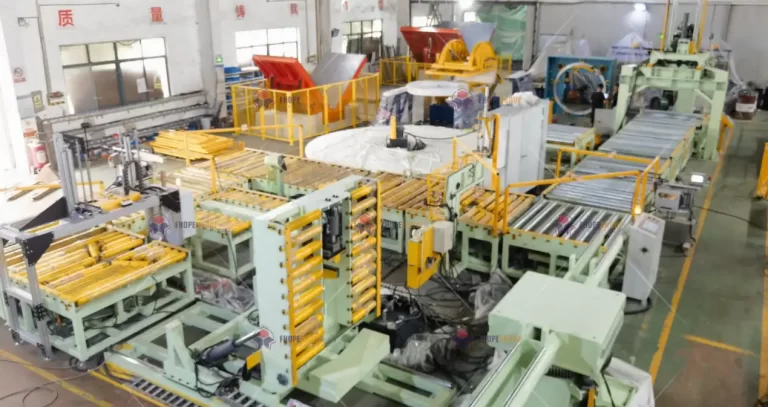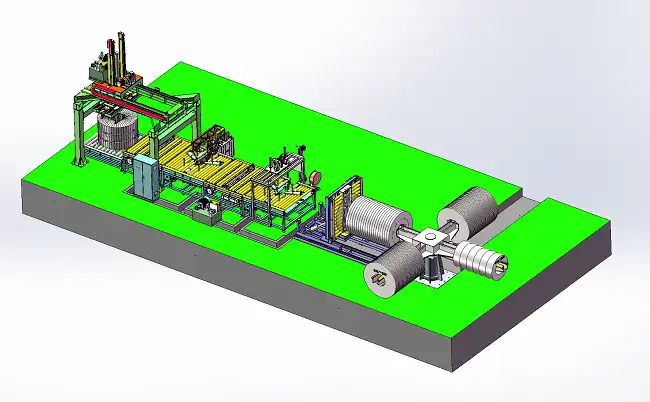Congratulations! You've taken the leap and installed an automated coil packing line in your facility. This significant investment promises to revolutionize your production process, boost efficiency, and elevate the quality of your packaged coils. However, the journey doesn't end with installation. To truly reap the benefits of your new system, you need to focus on optimizing its performance. In this comprehensive guide, we'll explore the strategies and best practices to fine-tune your automated coil packing line and maximize its potential.
Understanding the Importance of Post-Installation Optimization
Before we dive into the specifics, let's consider why optimization is crucial after installing an automated coil packing line:
- Maximizing ROI: Fine-tuning ensures you get the most value from your investment.
- Enhancing Efficiency: Optimization can significantly increase throughput and reduce waste.
- Improving Quality: Proper adjustment leads to consistently high-quality packaging.
- Extending Equipment Life: Optimal operation reduces wear and tear on components.
- Adapting to Your Specific Needs: Every facility is unique, and optimization tailors the system to your requirements.
With these benefits in mind, let's explore the step-by-step process of optimizing your automated coil packing line.
1. Establishing Baseline Performance Metrics
The first step in any optimization process is to establish a clear baseline:
- Measure Current Output: Document the number of coils packed per hour or shift.
- Assess Package Quality: Evaluate the consistency and integrity of packaged coils.
- Track Material Usage: Monitor the consumption of packaging materials.
- Record Downtime: Note the frequency and duration of any stoppages.
- Measure Energy Consumption: Document the energy used during operation.
These baseline metrics will serve as your reference point for improvement. Be sure to use precise measurement tools and consistent methodologies to ensure accurate data collection.
2. Analyzing the Production Flow
With baseline metrics in hand, it's time to take a closer look at your production flow:
- Identify Bottlenecks: Pinpoint areas where the process slows down or backs up.
- Examine Material Handling: Assess how coils and packaging materials move through the system.
- Evaluate Operator Interactions: Observe how your team interacts with the equipment.
- Analyze Data Flow: Check how information moves between different parts of the system.
Consider using value stream mapping to visualize your entire process. This technique can reveal inefficiencies and opportunities for improvement that might not be immediately apparent.
3. Fine-Tuning Machine Parameters
Your automated coil packing line likely has numerous adjustable parameters. Optimizing these can significantly impact performance:
- Adjust Speed Settings: Find the sweet spot between speed and quality.
- Calibrate Sensors: Ensure all sensors are accurately detecting coils and materials.
- Optimize Tension Control: Fine-tune wrapping tension for different coil types.
- Refine Cut and Seal Settings: Adjust for clean, secure package closures.
- Customize Program Sequences: Tailor operation sequences to your specific products.
Remember, these adjustments often require a balance. For example, increasing speed might impact package quality. Strive for the optimal combination that meets both your productivity and quality goals.
4. Enhancing Material Flow and Handling
Smooth material flow is crucial for efficient operation:
- Optimize Coil Loading: Ensure your coil loading mechanism is perfectly aligned and timed.
- Streamline Packaging Material Feed: Minimize snags or jams in the material delivery system.
- Refine Transfer Points: Smooth out any bumps or hitches as coils move between stations.
- Implement Buffer Zones: If necessary, create buffer areas to manage flow variations.
Consider implementing a pull system approach, where each stage of the process pulls materials from the previous stage only as needed. This can help prevent bottlenecks and reduce work-in-progress inventory.
5. Upgrading Operator Training and Procedures
Your team plays a crucial role in the performance of your automated line:
- Provide Advanced Training: Offer in-depth training on system operation and troubleshooting.
- Develop Clear SOPs: Create detailed, step-by-step procedures for all aspects of operation.
- Implement Cross-Training: Ensure multiple team members can handle various roles.
- Encourage Continuous Learning: Set up a system for ongoing skill development and knowledge sharing.

Remember, well-trained operators are your first line of defense against inefficiencies and can often spot potential issues before they become problems.
6. Implementing Advanced Control Systems
To take your automated coil packing line to the next level, consider implementing or upgrading advanced control systems:
- Integrate PLC Systems: Programmable Logic Controllers can significantly enhance automation and control.
- Implement HMI Interfaces: User-friendly Human-Machine Interfaces improve operator interaction and monitoring.
- Utilize Data Acquisition Systems: Gather real-time data for immediate performance insights.
- Consider AI and Machine Learning: These technologies can predict maintenance needs and optimize settings automatically.
Advanced control systems not only improve efficiency but also provide valuable data for ongoing optimization. For instance, a smart PLC system could automatically adjust wrapping tension based on coil size and material, ensuring consistent quality across different product types.
7. Optimizing Maintenance Practices
Proactive maintenance is key to sustaining peak performance:
- Develop a Preventive Maintenance Schedule: Regular check-ups prevent unexpected breakdowns.
- Implement Predictive Maintenance: Use data to predict when components might fail.
- Create a Spare Parts Inventory: Keep critical components on hand to minimize downtime.
- Train Maintenance Staff: Ensure your team can handle routine maintenance and quick fixes.
Consider implementing a Computerized Maintenance Management System (CMMS) to track maintenance activities, predict needs, and manage inventory. This systematic approach can significantly reduce downtime and extend equipment life.
8. Enhancing Quality Control Measures
Consistent quality is crucial for customer satisfaction and minimizing waste:
- Implement In-Line Quality Checks: Set up automated inspections at key points in the process.
- Utilize Vision Systems: Consider adding cameras to detect defects or misalignments.
- Develop a Quality Feedback Loop: Use quality data to continuously refine machine settings.
- Implement Statistical Process Control: Use statistical methods to monitor and control quality.
Remember, quality control isn't just about catching defects—it's about preventing them. By integrating quality measures throughout your process, you can identify and address issues before they result in wasted materials or rejected products.
9. Leveraging Data for Continuous Improvement
In today's digital age, data is a powerful tool for ongoing optimization:
- Implement IoT Sensors: Gather detailed data on every aspect of your operation.
- Utilize Data Analytics: Use advanced analytics to uncover trends and opportunities.
- Create Performance Dashboards: Provide real-time visibility into key performance indicators.
- Establish a Continuous Improvement Team: Dedicate resources to analyzing data and implementing improvements.
By becoming a data-driven operation, you can make informed decisions about everything from machine settings to maintenance schedules, leading to ongoing performance gains.
10. Optimizing Energy Efficiency
Improving energy efficiency can lead to significant cost savings:
- Conduct an Energy Audit: Identify areas of high energy consumption.
- Implement Energy Monitoring: Track energy use in real-time.
- Optimize Start-up and Shut-down Procedures: Reduce energy waste during non-productive times.
- Consider Energy-Efficient Components: When replacing parts, opt for energy-efficient alternatives.
Remember, energy optimization isn't just good for your bottom line—it's also beneficial for the environment and can be a selling point for environmentally conscious customers.
11. Streamlining Changeover Processes
If your line handles different coil types or packaging configurations, efficient changeovers are crucial:
- Implement SMED Techniques: Single-Minute Exchange of Die principles can dramatically reduce changeover times.
- Standardize Changeover Procedures: Create clear, step-by-step guides for each changeover type.
- Use Quick-Change Components: Invest in tools and parts designed for rapid changeovers.
- Practice and Time Changeovers: Regular practice can help teams become more efficient.
Efficient changeover processes can significantly increase your line's flexibility and overall productivity, allowing you to handle a diverse product mix without sacrificing efficiency.
12. Integrating with Broader Supply Chain Systems
Your automated coil packing line doesn't exist in isolation. Optimizing its integration with your broader supply chain can yield significant benefits:
- Implement ERP Integration: Connect your line data with your Enterprise Resource Planning system.
- Optimize Inventory Management: Use production data to fine-tune your inventory levels.
- Enhance Order Fulfillment: Streamline the connection between production and shipping.
- Implement Track and Trace Systems: Enhance product traceability throughout the supply chain.
By viewing your automated line as part of a larger integrated system, you can optimize not just the packing process, but your entire production and distribution workflow.
Conclusion: Embracing Continuous Optimization
Optimizing performance after installing an automated coil packing line is not a one-time event, but an ongoing journey. By establishing clear baselines, fine-tuning machine parameters, enhancing material flow, upgrading operator skills, implementing advanced control systems, and leveraging data for continuous improvement, you can ensure that your investment continues to deliver value for years to come.
Remember, the key to successful optimization lies in a holistic approach. It's not just about tweaking machine settings—it's about creating a culture of continuous improvement, where every aspect of the operation is regularly examined and refined. From energy efficiency to quality control, from maintenance practices to supply chain integration, every element plays a role in maximizing the performance of your automated coil packing line.
As you implement these strategies, you'll likely find that the benefits extend far beyond just increased output. You may see improvements in product quality, reductions in waste, enhanced worker satisfaction, and even new capabilities that open up fresh market opportunities.
In today's competitive manufacturing landscape, standing still is not an option. By committing to ongoing optimization of your automated coil packing line, you're not just improving a single process—you're positioning your entire operation for long-term success and growth. Embrace this mindset of continuous improvement, and watch as your automated coil packing line becomes a true cornerstone of your manufacturing excellence.





